As Stephanie Harvey (Language Arts, 2002) wrote, “Nonfiction is the genre most likely to spur children’s passion and wonder for learning” (12). Students enjoy learning about their world, and providing access to interesting nonfiction can provide them with a broad and an in-depth sense of the subject matter. With this in mind, the Children’s Literature and Reading Special Interest Group (CL/R SIG) offers these exemplary nonfiction literature selections to enhance content area (science, social studies, and math) connections for K–12 teachers. The selections explore various topics that can be read aloud or integrated within an in-depth unit of study.
ReadWriteThink provides teachers with many resources, including the following lesson plans pertaining to nonfiction: Adventures in Nonfiction: A guided inquiry journey, Investigating animals: Using nonfiction for inquiry-based research, and Using THIEVES to preview nonfiction texts.
Grades K–3
Chin, Jason. (2014). Gravity. New York, NY: Roaring Brook Press.
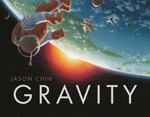 Jason Chin (www.jasonchin.net) has masterfully created another outstanding book for readers. Young children are fascinated by the world around them. Chin uses simple language and gorgeous watercolor and gouache illustrations to explain the concept of gravity. Through the use of familiar objects (sand toys and action figures), he illustrates how gravity works. He employs large bold face font through stellar double-page spreads to masterfully blend science with creativity. The use of repetitive phrases solidifies meaning and brings the story full circle. This clever book will ignite readers’ questions and lead them on a journey to find more nonfiction books about gravity. Classroom teachers will also find excellent information about the fundamentals of gravity.
Jason Chin (www.jasonchin.net) has masterfully created another outstanding book for readers. Young children are fascinated by the world around them. Chin uses simple language and gorgeous watercolor and gouache illustrations to explain the concept of gravity. Through the use of familiar objects (sand toys and action figures), he illustrates how gravity works. He employs large bold face font through stellar double-page spreads to masterfully blend science with creativity. The use of repetitive phrases solidifies meaning and brings the story full circle. This clever book will ignite readers’ questions and lead them on a journey to find more nonfiction books about gravity. Classroom teachers will also find excellent information about the fundamentals of gravity.
- Mary Napoli, Penn State Harrisburg
Jenkins, S. (2014). Eye to eye: How animals see the world. Boston, MA: Houghton Mifflin Harcourt.
 Once again using cut and torn paper, artist and author Steve Jenkins invites readers to get up close and personal with living creatures. Jenkins’ unique and engaging art will attract readers but the informational content here will be just as appealing. The close-up images of animals from a butterfly to a hippopotamus are set against plain white background. There is ample white space and each entry has a clever heading such as “zip it” or “if looks could kill.” These titles are set off in a difficult color type and the names of the animals are then highlighted in bold print. This consistency layout makes the book easy to navigate. The language used is straightforward as readers learn about the first eyes and then explore the four kinds of eyes found in the animal world. Plenty of back matter contains animal facts, a glossary, and diagrams illustrating the evolution of the eye.
Once again using cut and torn paper, artist and author Steve Jenkins invites readers to get up close and personal with living creatures. Jenkins’ unique and engaging art will attract readers but the informational content here will be just as appealing. The close-up images of animals from a butterfly to a hippopotamus are set against plain white background. There is ample white space and each entry has a clever heading such as “zip it” or “if looks could kill.” These titles are set off in a difficult color type and the names of the animals are then highlighted in bold print. This consistency layout makes the book easy to navigate. The language used is straightforward as readers learn about the first eyes and then explore the four kinds of eyes found in the animal world. Plenty of back matter contains animal facts, a glossary, and diagrams illustrating the evolution of the eye.
- Lesley Colabucci, Millersville University of Pennsylvania
O’Connell, Caitlin. (2014). A baby elephant in the wild. Photographs by Caitlin O’Connell & Timothy Rodwell. New York, NY: Houghton Mifflin Harcourt.
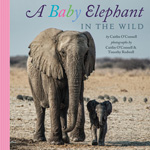 This nonfiction photo essay provides readers with first-hand information about the daily activities of a baby elephant in Namibia’s Estosha National Park. Researcher and scientist Caitlin O’Connell (author of The Elephant Scientists, 2011 Sibert Honor) and her husband/photographer have been studying elephant behavior for over fifteen years. During a field study expedition, they were fortunate to witness the birth of a baby elephant, known as Liza. Through accessible language, readers learn about Liza’s close relationship with her mother and extended family. Charming photographs capture Liza’s first mud bath and the use of her trunk to say hello to other elephants. The book also contains a “Did you know?” section with additional facts to compel readers to learn more about elephants and to heed the author’s message to “become guardians of the elephants” (dedication).
This nonfiction photo essay provides readers with first-hand information about the daily activities of a baby elephant in Namibia’s Estosha National Park. Researcher and scientist Caitlin O’Connell (author of The Elephant Scientists, 2011 Sibert Honor) and her husband/photographer have been studying elephant behavior for over fifteen years. During a field study expedition, they were fortunate to witness the birth of a baby elephant, known as Liza. Through accessible language, readers learn about Liza’s close relationship with her mother and extended family. Charming photographs capture Liza’s first mud bath and the use of her trunk to say hello to other elephants. The book also contains a “Did you know?” section with additional facts to compel readers to learn more about elephants and to heed the author’s message to “become guardians of the elephants” (dedication).
- Mary Napoli, Penn State Harrisburg
Pringle, Laurence. The secret life of the woolly bear caterpillar. Illus. by Joan Paley. Honesdale, PA: Boyds Mills Press.
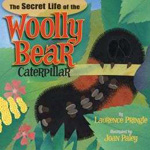 Laurence Pringle, author of more than 100 books for children, shares his penchant for research in his latest informational picture book. In this informative book, readers meet a woolly bear caterpillar named Bella. Each page offers clear facts and accessible information about the life cycle of Bella throughout the seasons. During the spring, the caterpillar turns into a beautiful Tiger Moth and lays eggs in order for the cycle to continue once again. The cut paper and mixed media illustrations add charm to Bella’s journey. The key terms of the insect’s body parts are italicized and defined in the glossary. Pringle includes an extensive back matter section with additional information about the woolly bear caterpillar and a diagram of its body.
Laurence Pringle, author of more than 100 books for children, shares his penchant for research in his latest informational picture book. In this informative book, readers meet a woolly bear caterpillar named Bella. Each page offers clear facts and accessible information about the life cycle of Bella throughout the seasons. During the spring, the caterpillar turns into a beautiful Tiger Moth and lays eggs in order for the cycle to continue once again. The cut paper and mixed media illustrations add charm to Bella’s journey. The key terms of the insect’s body parts are italicized and defined in the glossary. Pringle includes an extensive back matter section with additional information about the woolly bear caterpillar and a diagram of its body.
- Mary Napoli, Penn State Harrisburg
Grades 3–5
Adler, David. (2014). Triangles. Illus. by Edward Miller. New York, NY: Holiday House.
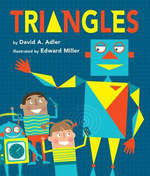 In this informative math picture book, Adler introduces readers to angles, different types of triangles, and information about similar and congruent triangles. Through bold and colorful illustrations, concise language, and bold-face vocabulary terms, readers follow two children who experiment with triangles. They draw, measure, and classify triangles to eventually build a robot made mostly of triangles. Adler also introduces activity directions to support math and reading connections. Partner this book with Adler’s other math concept books such as Shape Up: Fun With Triangles and Other Polygons (2000) and Perimeter, Area, Volume: A Monster Book of Dimensions (2012). Visit the author’s website at www.davidadler.com for more information.
In this informative math picture book, Adler introduces readers to angles, different types of triangles, and information about similar and congruent triangles. Through bold and colorful illustrations, concise language, and bold-face vocabulary terms, readers follow two children who experiment with triangles. They draw, measure, and classify triangles to eventually build a robot made mostly of triangles. Adler also introduces activity directions to support math and reading connections. Partner this book with Adler’s other math concept books such as Shape Up: Fun With Triangles and Other Polygons (2000) and Perimeter, Area, Volume: A Monster Book of Dimensions (2012). Visit the author’s website at www.davidadler.com for more information.
- Mary Napoli, Penn State Harrisburg
Brown, D. (2014). He has shot the president! New York, NY: Roaring Brook Press.
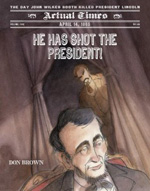 This is the newest addition to Brown’s “archival times” series, which takes a journalistic approach to landmark events. The dust jacket and matching cloth cover indicates April 14, 1865 as the date of this edition of the “times” and offers the subtitle, the day John Wilkes Booth killed President Lincoln. This narrative style offers a fast-paced but fact-filled presentation of the story of the assassination and the ensuing events. The accompanying watercolor illustrations set a somber mood but also capture the intensity of emotions on character’s faces. The story moves chronologically alternating in focus on Booth and Lincoln. Individual characters are highlighted to help readers follow the players as events unfold. There is a map of the area to help with following the action. The graphic portions of the story are delivered in a straightforward style, both visually (bloody knife, images of hangings) and in the text (“…the rebel had a Union revolver pointed at his temple”).
This is the newest addition to Brown’s “archival times” series, which takes a journalistic approach to landmark events. The dust jacket and matching cloth cover indicates April 14, 1865 as the date of this edition of the “times” and offers the subtitle, the day John Wilkes Booth killed President Lincoln. This narrative style offers a fast-paced but fact-filled presentation of the story of the assassination and the ensuing events. The accompanying watercolor illustrations set a somber mood but also capture the intensity of emotions on character’s faces. The story moves chronologically alternating in focus on Booth and Lincoln. Individual characters are highlighted to help readers follow the players as events unfold. There is a map of the area to help with following the action. The graphic portions of the story are delivered in a straightforward style, both visually (bloody knife, images of hangings) and in the text (“…the rebel had a Union revolver pointed at his temple”).
- Lesley Colabucci, Millersville University of Pennsylvania
Campbell, Sarah C. (2014). Mysterious patterns: Finding fractals in nature. Photographs by Sarah C. & Richard P. Campbell. Honesdale, PA: Boyds Mills Press.
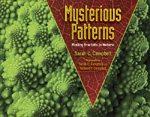 Have you ever heard of fractals? What about Benoit Mandelbrot? Through concise language and beautiful, full-color photographs, readers will learn information about fractals found in nature. As author/photographer Susan Campbell explains, “every fractal shape has smaller parts that look like a whole shape” (p. 12). Throughout the text, the author provides examples of fractals and non-fractal patterns. There is also a brief biographical sketch about Mandelbrot, a mathematician, who first coined the term “fractals” in 1975. Readers will want to visit Campbell’s website at www.sarahcampbell.com for more information about her books (including Growing Patterns: Fibonacci numbers in nature, 2010) and for directions on how to make a pop-up fractal book.
Have you ever heard of fractals? What about Benoit Mandelbrot? Through concise language and beautiful, full-color photographs, readers will learn information about fractals found in nature. As author/photographer Susan Campbell explains, “every fractal shape has smaller parts that look like a whole shape” (p. 12). Throughout the text, the author provides examples of fractals and non-fractal patterns. There is also a brief biographical sketch about Mandelbrot, a mathematician, who first coined the term “fractals” in 1975. Readers will want to visit Campbell’s website at www.sarahcampbell.com for more information about her books (including Growing Patterns: Fibonacci numbers in nature, 2010) and for directions on how to make a pop-up fractal book.
- Mary Napoli, Penn State Harrisburg
Huey, L.M. (2014). Ick! Yuck! Eww!: Our gross American history. Minneapolis, MN: Millbrook Press.
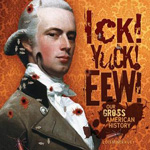 Just a sample of the chapter headings from this book captures the overall approach to history presented: The Awful Smells, The Creepy-Crawly Bugs, and The Nasty Germs. Young readers may be drawn to this book for the initial shock value, but the connections made to common historical content will keep them reading. The author’s work as an archeologist clearly informed the focus of the book, adding to its credibility and the passionate writing style. The author has stocked the text with questions and exclamations, such as a description of a barber pulling a tooth that ends with “Yuck! Who knew barbers were also dentists” (p. 26)? The pages are layered with textual and visual elements that keep the text interactive. Archival material and contemporary photography is used and always fully captioned. Most pages contain sidebars that are clearly labeled. Ample back matter is included along with an abbreviated index.
Just a sample of the chapter headings from this book captures the overall approach to history presented: The Awful Smells, The Creepy-Crawly Bugs, and The Nasty Germs. Young readers may be drawn to this book for the initial shock value, but the connections made to common historical content will keep them reading. The author’s work as an archeologist clearly informed the focus of the book, adding to its credibility and the passionate writing style. The author has stocked the text with questions and exclamations, such as a description of a barber pulling a tooth that ends with “Yuck! Who knew barbers were also dentists” (p. 26)? The pages are layered with textual and visual elements that keep the text interactive. Archival material and contemporary photography is used and always fully captioned. Most pages contain sidebars that are clearly labeled. Ample back matter is included along with an abbreviated index.
- Lesley Colabucci, Millersville University of Pennsylvania
Grades 6–8
Carson, M.K. (2014). Park scientists: Gila monsters, geysers, and grizzly bears in American’s own backyard. Illus. by Tom Uhlman. Boston, MA: Houghton Mifflin Harcourt.
 Continuing in the tradition the “Scientists in the Field” series, this book presents the work of scientists inYellowstone, Saguaro, and Great Smoky Mountains National Parks. Readers accompany scientists (geologists, entomologist, and wildlife biologists) as they study and protect plant and animal life in three distinct parts of the country. The book starts with a helpful map of the U.S. and resources on national parks. Each section begins with a “park brief” featuring facts, a map, and related websites. The page layouts include crisp, clean photography as well as diagrams and charts. All are clearly labeled and described. The text contains plenty of headings and is written in an informational style that makes somewhat difficult topics (bioluminescence, DNA sampling) accessible to young readers. Expert research went into this book as evidenced through the primary sources cited throughout and thoroughly detailed in the back matter.
Continuing in the tradition the “Scientists in the Field” series, this book presents the work of scientists inYellowstone, Saguaro, and Great Smoky Mountains National Parks. Readers accompany scientists (geologists, entomologist, and wildlife biologists) as they study and protect plant and animal life in three distinct parts of the country. The book starts with a helpful map of the U.S. and resources on national parks. Each section begins with a “park brief” featuring facts, a map, and related websites. The page layouts include crisp, clean photography as well as diagrams and charts. All are clearly labeled and described. The text contains plenty of headings and is written in an informational style that makes somewhat difficult topics (bioluminescence, DNA sampling) accessible to young readers. Expert research went into this book as evidenced through the primary sources cited throughout and thoroughly detailed in the back matter.
- Lesley Colabucci, Millersville University of Pennsylvania.
Freedman, R. (2014). Angel Island: Gateway to Gold Mountain. Boston, MA: Houghton Mifflin Harcourt.
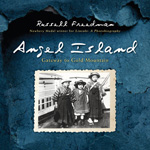 Readers may be surprised to learn of the “Ellis Island of the West.” Angel Island in San Francisco Bay is now a National Historic Landmark. Over 80,000 immigrants attempted to enter the U.S. at this much less welcoming port. As readers have come to expect, Freedman documents this history with the use of photographs on nearly every page and meticulous source notes. Many nationalities passed through the Angel Island Immigration Station, but this book focuses on the treatment of the Chinese. The heart of this book lies in the description of the detention barracks where some were held for weeks. Poems translated from the walls of the walls of the barracks add a personal feel and capture the heartache of the experience: “I raise my brush and write a poem to tell my wife, /In the middle of last night, I sighed at our being apart” (p. 61).
Readers may be surprised to learn of the “Ellis Island of the West.” Angel Island in San Francisco Bay is now a National Historic Landmark. Over 80,000 immigrants attempted to enter the U.S. at this much less welcoming port. As readers have come to expect, Freedman documents this history with the use of photographs on nearly every page and meticulous source notes. Many nationalities passed through the Angel Island Immigration Station, but this book focuses on the treatment of the Chinese. The heart of this book lies in the description of the detention barracks where some were held for weeks. Poems translated from the walls of the walls of the barracks add a personal feel and capture the heartache of the experience: “I raise my brush and write a poem to tell my wife, /In the middle of last night, I sighed at our being apart” (p. 61).
- Lesley Colabucci, Millersville University of Pennsylvania
Mulder, Michelle. (2014). Every last drop: Bringing clean water home. Custer, WA: Orca Book Publishers.
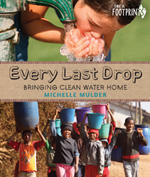 This accessible and engaging nonfiction book sheds important research about water around the world. The author combines personal stories with interesting facts to raise awareness in an effort to encourage personal responsibility about water usage. Organized by chapters, each section contains colorful photographs, information, and “water fact” captions about water, how unclean it is in certain parts of the world, and how individuals found creative ways to access clean water. The author, a water advocate, supplies readers with important information along with an underlying message to preserve our nature’s resources. Throughout the book, she includes photos from people around the world who have made significant efforts to improve the clean water supply. She mentions information about Wangari Maathai, who won the Nobel Peace Prize in 2004 for her contribution to sustainable development. In addition, she shares information about Ryan Hreljac who started the Ryan’s Well Foundation in an effort to raise money for water projects. Classroom and school libraries will want to include this important nonfiction book in a text set about sustainability of natural resources. Partner with The Story of Wangari Maathai (Nivola, 2008) , Wangari’s Trees of Peace: A True Story from Africa (Winter, 2008), Mama Miti: Wangari Maathai and the Trees of Kenya (Napoli, 2010), Seeds of Change: Planting a Path to Peace (Johnson, 2010), Ryan and Jimmy: and the Well in Africa That Brought Them Together (Shoveller, 2008), A Drop Around the World (McKinney, 1998), and One Well: The Story of Water on Earth (Strauss, 2007).
This accessible and engaging nonfiction book sheds important research about water around the world. The author combines personal stories with interesting facts to raise awareness in an effort to encourage personal responsibility about water usage. Organized by chapters, each section contains colorful photographs, information, and “water fact” captions about water, how unclean it is in certain parts of the world, and how individuals found creative ways to access clean water. The author, a water advocate, supplies readers with important information along with an underlying message to preserve our nature’s resources. Throughout the book, she includes photos from people around the world who have made significant efforts to improve the clean water supply. She mentions information about Wangari Maathai, who won the Nobel Peace Prize in 2004 for her contribution to sustainable development. In addition, she shares information about Ryan Hreljac who started the Ryan’s Well Foundation in an effort to raise money for water projects. Classroom and school libraries will want to include this important nonfiction book in a text set about sustainability of natural resources. Partner with The Story of Wangari Maathai (Nivola, 2008) , Wangari’s Trees of Peace: A True Story from Africa (Winter, 2008), Mama Miti: Wangari Maathai and the Trees of Kenya (Napoli, 2010), Seeds of Change: Planting a Path to Peace (Johnson, 2010), Ryan and Jimmy: and the Well in Africa That Brought Them Together (Shoveller, 2008), A Drop Around the World (McKinney, 1998), and One Well: The Story of Water on Earth (Strauss, 2007).
- Mary Napoli, Penn State Harrisburg
Grades 9–12
Finkelstein, Norman. (2014). Schools of hope: How Julius Rosenwald helped change African American education. Honesdale, PA: Calkins Creek.
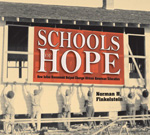 Julius Rosenwald, President of Sears, Roebuck and Company during the 1900s, lived by the motto “give while you live.” Strongly influenced by Jane Addams message that “civilization is a method of living an attitude of respect for all people” (22), Rosenwald gave money to groups of individuals whose members also contributed to their organization. As a result, he supported the YMCA. Then he met Dr. Booker T. Washington and with his guidance resolved to improve the lives of African Americans. Eventually, Rosenwald established a foundation to build more than five thousand new schools in fifteen southern states for African American children. There was one caveat in that communities had to participate in collective fundraising and building efforts. Through this collaborative approach to community involvement, schools were built from1912-1932. Today, there is a growing interest to preserve the remaining school sites for cultural and historical purposes. This nonfiction text is well-researched and includes period photographs, source notes, a bibliography, and websites.
Julius Rosenwald, President of Sears, Roebuck and Company during the 1900s, lived by the motto “give while you live.” Strongly influenced by Jane Addams message that “civilization is a method of living an attitude of respect for all people” (22), Rosenwald gave money to groups of individuals whose members also contributed to their organization. As a result, he supported the YMCA. Then he met Dr. Booker T. Washington and with his guidance resolved to improve the lives of African Americans. Eventually, Rosenwald established a foundation to build more than five thousand new schools in fifteen southern states for African American children. There was one caveat in that communities had to participate in collective fundraising and building efforts. Through this collaborative approach to community involvement, schools were built from1912-1932. Today, there is a growing interest to preserve the remaining school sites for cultural and historical purposes. This nonfiction text is well-researched and includes period photographs, source notes, a bibliography, and websites.
- Mary Napoli, Penn State Harrisburg
Mitchel, D. (2014). The Freedom Summer murders. New York, NY: Scholastic Press.
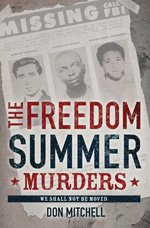 This book was written to coincide with the 50th anniversary of the murder of three civil rights activists in 1964 in Neshoba County, Mississippi. The Freedom Summer movement was underway, and these three young men were helping to register African American voters when they were brutally lynched by the KKK. Each victim is featured in their own biographical chapter. The chapter on Andrew Goodman, a white man, ends with a postcard he sent to his parents commenting on the “wonderful” town and people upon his arrival in Mississippi. James Earl Chaney, an African American, was highly committed to nonviolence even before his involvement in the movement. Michael Henry Schwerner, who was Jewish, was especially proud of having successfully pledged an African American to his fraternity at Cornell. Additional brief biographies of key players are offered in the extensive back matter in this book. This powerful nonfiction selection succeeds in documenting the investigation into the murders, the 1967 trial that brings justice, and the importance of this event in the larger context of the civil movement.
This book was written to coincide with the 50th anniversary of the murder of three civil rights activists in 1964 in Neshoba County, Mississippi. The Freedom Summer movement was underway, and these three young men were helping to register African American voters when they were brutally lynched by the KKK. Each victim is featured in their own biographical chapter. The chapter on Andrew Goodman, a white man, ends with a postcard he sent to his parents commenting on the “wonderful” town and people upon his arrival in Mississippi. James Earl Chaney, an African American, was highly committed to nonviolence even before his involvement in the movement. Michael Henry Schwerner, who was Jewish, was especially proud of having successfully pledged an African American to his fraternity at Cornell. Additional brief biographies of key players are offered in the extensive back matter in this book. This powerful nonfiction selection succeeds in documenting the investigation into the murders, the 1967 trial that brings justice, and the importance of this event in the larger context of the civil movement.
- Lesley Colabucci, Millersville University of Pennsylvania
Sheinkin, S. (2014). The Port Chicago 50: Disaster, mutiny, and the fight for civil rights. New York, NY: Roaring Brook Press.
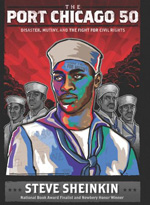 In 1944, few jobs were available to African Americans serving in the U.S. Navy. Many African American sailors spent their days loading bombs and ammunition into vessels headed to the Pacific. When an explosion injured hundreds of men, Joe Small decided to take a stand and lead a protest against the unsafe and unfair working conditions; only African Americans were assigned to this job, and they had received no training. This book chronicles the revolt, which was deemed a mutiny, persuasively drawing connections between this forgotten incident and the broader context of the emerging civil rights movement. A trusted name in nonfiction, Sheinkin’s research is impeccable. Back matter includes six pages of indices, detailed photo credits, source notes by chapter, and a separate section detailing primary source materials.
In 1944, few jobs were available to African Americans serving in the U.S. Navy. Many African American sailors spent their days loading bombs and ammunition into vessels headed to the Pacific. When an explosion injured hundreds of men, Joe Small decided to take a stand and lead a protest against the unsafe and unfair working conditions; only African Americans were assigned to this job, and they had received no training. This book chronicles the revolt, which was deemed a mutiny, persuasively drawing connections between this forgotten incident and the broader context of the emerging civil rights movement. A trusted name in nonfiction, Sheinkin’s research is impeccable. Back matter includes six pages of indices, detailed photo credits, source notes by chapter, and a separate section detailing primary source materials.
- Lesley Colabucci, Millersville University of Pennsylvania
Nonfiction-Related Blogs, Resources, and Awards:
These reviews and resources are submitted by members of the International Reading Association’s Children’s Literature and Special Interest Group (CL/R SIG) and are published weekly on Reading Today Online.